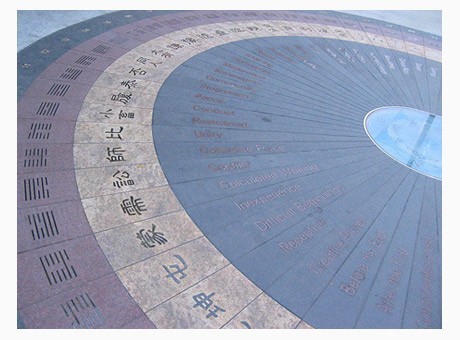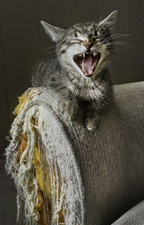 Feng shui can best be thought of as an ancient Chinese practice that some think employs the laws of Heaven as well as Earth to assist in improving the life of the average person. This improvement comes by way of getting some positive qi. The phrase feng shui can be taken as the literal meaning of wind-water. The origins of feng shui can be traced all the way back to Hongshan and Yangshao cultures. Hongshan culture was a Neolithic culture in the northeast of China, which lasted from 4700 BC all the way to 2900 BC, while the Yangshao culture was another Neolithic culture in China that lasted from 5000 BC to 3000 BC. Today, traditional feng shui is still practiced by Chinese people and also New Age entrepreneurs, who have brought it to the West with, however, some losses in translation.
Feng shui can best be thought of as an ancient Chinese practice that some think employs the laws of Heaven as well as Earth to assist in improving the life of the average person. This improvement comes by way of getting some positive qi. The phrase feng shui can be taken as the literal meaning of wind-water. The origins of feng shui can be traced all the way back to Hongshan and Yangshao cultures. Hongshan culture was a Neolithic culture in the northeast of China, which lasted from 4700 BC all the way to 2900 BC, while the Yangshao culture was another Neolithic culture in China that lasted from 5000 BC to 3000 BC. Today, traditional feng shui is still practiced by Chinese people and also New Age entrepreneurs, who have brought it to the West with, however, some losses in translation.
 With respect to architecture, feng shui plays a very significant role, especially in deciding the form of the space in consideration. The concept of feng shui basically is concerned with keeping harmony and peace in the flow of the architecture of any structure. This structure can be something as imposing as an office building, yet it can also be as simple as the interior space of one’s living room or any other room in a residence. The architecture behind feng shui is such that any space should be designed so that there is a regular flow of positive energy or qi. Precision is necessary in feng shui design, and this can be seen no better than the incorporation of a compass or even a Luo Pan to decide which the favorable positioning of certain rooms in a house or building.
With respect to architecture, feng shui plays a very significant role, especially in deciding the form of the space in consideration. The concept of feng shui basically is concerned with keeping harmony and peace in the flow of the architecture of any structure. This structure can be something as imposing as an office building, yet it can also be as simple as the interior space of one’s living room or any other room in a residence. The architecture behind feng shui is such that any space should be designed so that there is a regular flow of positive energy or qi. Precision is necessary in feng shui design, and this can be seen no better than the incorporation of a compass or even a Luo Pan to decide which the favorable positioning of certain rooms in a house or building.
- Environment and Feng Shui
- Architectural Feng Shui
- Feng Shui and Hospitals
- Qi in Feng Shui
- All About Feng Shui
 With regards to tombs, feng shui was used to orient them because of their important, spiritual significance. By about 3000 BC, feng shui was being used in many Chinese cities like Puyang and Mawangdui because of the presence of tombs in those locations. Liuren astrolabes were some of the oldest tools used for feng shui, and some have even been excavated from Chinese tombs that date to 250 BC. Even in pre-modern China, it was discovered that feng shui used on tombs had as much importance as feng shui used in private homes.
With regards to tombs, feng shui was used to orient them because of their important, spiritual significance. By about 3000 BC, feng shui was being used in many Chinese cities like Puyang and Mawangdui because of the presence of tombs in those locations. Liuren astrolabes were some of the oldest tools used for feng shui, and some have even been excavated from Chinese tombs that date to 250 BC. Even in pre-modern China, it was discovered that feng shui used on tombs had as much importance as feng shui used in private homes.
- History of Feng Shui
- Feng Shui and Tombs
- Feng Shui and Cremations
- Ming Tombs and Feng Shui
- Feng Shui and the Ming Tombs
Feng shui is most commonly known as a practice that is applied to people’s homes, particularly in China. In homes, the Chinese use feng shui for medical purposes in addition to helping their homes find a peaceful and harmonious atmosphere. In China, the belief is that incorporating feng shui in the home will provide a profound, curative effect on one’s life. Feng shui is not so much about furniture rearrangement as it is about spiritual connection.
Feng shui in the home begins by clearing out any clutter at home and making space for good-quality air and light. Before one should even get into arranging the furniture in a home and worrying about its layout, one has to define the energy map of the home by using a compass. After that, one has to familiarize himself or herself with the five elements of theory in feng shui, as well as knowing one’s feng shui birth element. Knowing one’s Kua number and the state of the home are also integral to successful feng shui design.
- Design Tips for Feng Shui
- How Feng Shui works
- Feng Shui Explained
- Decorating with Feng Shui
- Tips for Home Feng Shui
 Both the layout of one’s home as well as the layout of the furniture are said to be filled with life energy, just as natural wonders in nature; so believe the Chinese. In feng shui, the belief is that certain objects and furniture in the home can actually have a negative burden on one’s spirit, especially if they are arranged in a wrong way where the energy flow of the home is impeded. Feng shui is important, thus, in helping to improve the spiritual quality of one’s home by laying out the furniture in such a way that the energy flow is no longer impeded. Feng shui will try to use all elements in a room, such as furniture or even mirrors, plants, the color of the walls, etc.; to bring balance back to the all-important way that the energy inside the whole home flows around. Achieving this all-crucial energy balance in the home is the goal of a feng shui decorator and practitioner, and it is thought to improve the spiritual life and the mood of the person living inside such a space. Organizations like the International Feng Shui Guild promote awareness of feng shui and are consultants for aims like bringing feng shui into the home.
Both the layout of one’s home as well as the layout of the furniture are said to be filled with life energy, just as natural wonders in nature; so believe the Chinese. In feng shui, the belief is that certain objects and furniture in the home can actually have a negative burden on one’s spirit, especially if they are arranged in a wrong way where the energy flow of the home is impeded. Feng shui is important, thus, in helping to improve the spiritual quality of one’s home by laying out the furniture in such a way that the energy flow is no longer impeded. Feng shui will try to use all elements in a room, such as furniture or even mirrors, plants, the color of the walls, etc.; to bring balance back to the all-important way that the energy inside the whole home flows around. Achieving this all-crucial energy balance in the home is the goal of a feng shui decorator and practitioner, and it is thought to improve the spiritual life and the mood of the person living inside such a space. Organizations like the International Feng Shui Guild promote awareness of feng shui and are consultants for aims like bringing feng shui into the home.



 The basic equipment needed to start bird watching is quite minimal. A standard set normally includes a notepad, a published bird field guide, and a reliable pair of binoculars. The field guide is especially useful in helping to identify different species of birds, while the notepad is used to detail new sightings. Many bird watchers also like to photograph birds as part of their note-taking process. Photographing the birds helps with species identification, especially if the bird flies off after only a brief time. Since bird watching takes place outdoors, bird watchers need to be well prepared so that they can stay outside comfortably for extended periods of time. To do this, come prepared with appropriate clothing (including a hat, sunglasses and walking shoes), sunscreen, and mosquito repellent. Other items such as a cell phone, a map, a first aid kit, a compass, snacks and water are particularly useful for day journeys or trips into unknown areas.
The basic equipment needed to start bird watching is quite minimal. A standard set normally includes a notepad, a published bird field guide, and a reliable pair of binoculars. The field guide is especially useful in helping to identify different species of birds, while the notepad is used to detail new sightings. Many bird watchers also like to photograph birds as part of their note-taking process. Photographing the birds helps with species identification, especially if the bird flies off after only a brief time. Since bird watching takes place outdoors, bird watchers need to be well prepared so that they can stay outside comfortably for extended periods of time. To do this, come prepared with appropriate clothing (including a hat, sunglasses and walking shoes), sunscreen, and mosquito repellent. Other items such as a cell phone, a map, a first aid kit, a compass, snacks and water are particularly useful for day journeys or trips into unknown areas. The biggest questions that most new bird watchers have are where and when to start observing birds. It helps to have a guide or checklist that indicates which birds are prevalent in certain areas during each season. Although a backyard, public garden, or local bird sanctuary are good places to start, rarer birds can usually be found in forests and woods. When setting up in an area, be very quiet and be prepared to stay there for some time. Often patience is rewarded when a bird watcher stays in one place for a long time. This allows the birds to get used to the person being there and they eventually get over their skittishness. Always respect the birds, their habitats, and other creatures that make their homes there. Do not leave any trash behind or destroy plants, trees, or nests.
The biggest questions that most new bird watchers have are where and when to start observing birds. It helps to have a guide or checklist that indicates which birds are prevalent in certain areas during each season. Although a backyard, public garden, or local bird sanctuary are good places to start, rarer birds can usually be found in forests and woods. When setting up in an area, be very quiet and be prepared to stay there for some time. Often patience is rewarded when a bird watcher stays in one place for a long time. This allows the birds to get used to the person being there and they eventually get over their skittishness. Always respect the birds, their habitats, and other creatures that make their homes there. Do not leave any trash behind or destroy plants, trees, or nests.

